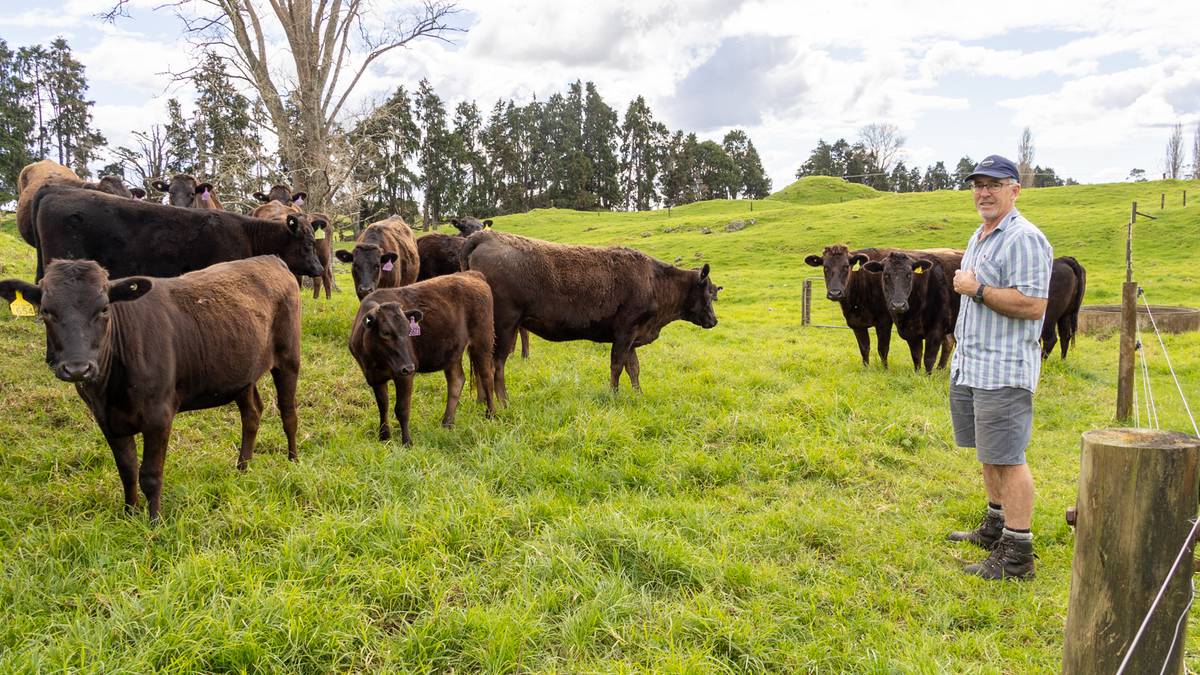Malcom Collier, president of the New Zealand Wagyu Breeders Association, has moved to Northland. Photo / Donna Russell
One of New Zealand’s longest-standing Wagyu breeders has moved to Northland.
Malcom Collier is president of the New Zealand Wagyu Breeders Association.
In March this year he brought his entire herd of the fabled meat
cattle to Pakaraka, near Kawakawa, and is relishing the extra space 90ha affords, with another 60ha leased from a next-door neighbour.
Collier and his wife, Chari, who is a writer, are settling into their new farm which doesn’t include a house. Currently they are renting a cottage nearby and spreading out to a large caravan for a bit of space.
His prized herd of 200 cattle is now roaming the gentle rolling pastures in 60 paddocks set amongst volcanic rocks and dry-stone walls as he pursues his Wakarua Wagyu farming venture.
Collier grew up in the Taihape hill country where several generations of his family have farmed sheep and beef since the 1880s. In 1994 he started farming Wagyu cattle.
In 2008 he moved away to manage the infrastructure for Lifeway College, a Christian school at Snells Beach, and had his herd on various lease blocks around Matakana and Snells Beach districts.
Now he is happy to have all of his cattle in one place with the room to expand the operation.
/cloudfront-ap-southeast-2.images.arcpublishing.com/nzme/WCKRXII5NNI2UBSAOKOOG2D55Y.jpg)
The Wagyu breed originated in Japan and the name literally translates as “Japanese cow”.
Its highly marbled and tender meat is considered a delicacy across the world. It has up to 300 per cent more monosaturated fat than other beef. Wagyu cattle are also genetically disposed to have a higher percentage of omega-3 and omega-6 fatty acids, making it a healthier option than most other red meats and more akin to salmon and olive oil.
Collier has built up his herd from a base of Wagyu/Friesian cross to now having all purebreds as well as full bloods where both dam and sire are from Japan.
“It’s been more than 25 years of breeding to get the herd where it is now and, over the last five years, I’ve been pursuing an embryo transfer programme with the aim of upgrading the herd to be all full blood,” he said.
The upgrading process is highly scientific, with a private specialist technician brought in to conduct the embryo transfers for each breeding cycle.
“It’s quite tricky and expensive and is only successful in about 50 per cent of the transfers,” he said.
Careful cattle management is needed to ensure the breeding cows being kept for the embryo transfers are not impregnated by the Wagyu bulls on the property or, in a worst-case scenario, by any bulls of other breeds from neighbouring properties.
While Wagyu cattle are traditionally finished on grain in Japan and Australia, Collier raises his cattle entirely on grass.
“Grain feeding is a very expensive model of farming/finishing. Some New Zealand farmers use grass feeding and then finish the cattle on grain. But it’s down to personal taste and grass-fed Wagyu is still wonderful.”
The Asian palate was more attuned to grain-fed meat where the fat marbling is prized for being “as white as snow” whereas the intramuscular fat in meat in grass-fed animals had a yellowish tinge because of the carotene in grass”, Collier said.
A New Zealand meat company which processes Wagyu carcases has special criteria for assessing the meat with grades attracting premiums, up to $3 a kg above meat from other breeds.
“It’s not easy to get the highest premiums,” he said.
“Wagyu cattle also take longer to grow, as the marbling effect develops progressively when the cattle are grass-fed. Optimum grading isn’t reached until the animal is at least three years old.”
/cloudfront-ap-southeast-2.images.arcpublishing.com/nzme/JXVURYJMIQE32SGVUQRQ2SHHGI.jpg)
Collier uses DNA testing to verify the parentage of his calves so they can be correctly entered in the national herd register.
This is kept by the New Zealand Wagyu Breeders Association using an Australian database management system.
As president, Collier is keen to develop the register as a useful platform for the association to build its brand.
The association was started in 1992 but went into recess in the late 1990s when the breed didn’t seem to be gaining traction.
“There were a few stubborn people like me who kept with the breed and so we revived the association a few years ago. Now we have about 30 members from throughout New Zealand.
“Luckily the information from the early database was kept so we have been able to build on that.
“Our goal is to provide a reliable avenue for registering Wagyu genetics and facilitate a meaningful network in the Wagyu community,” Collier said.
Despite the potential high returns, life as a Wagyu breeder required “walking slowly and being patient” as the costs involved in building a fullblood herd could be eye-wateringly expensive, he said.




